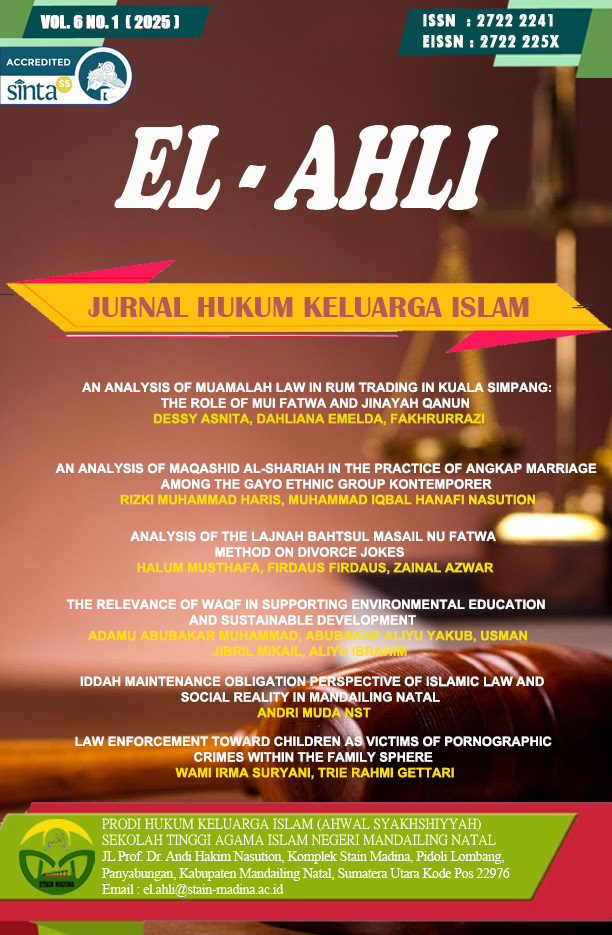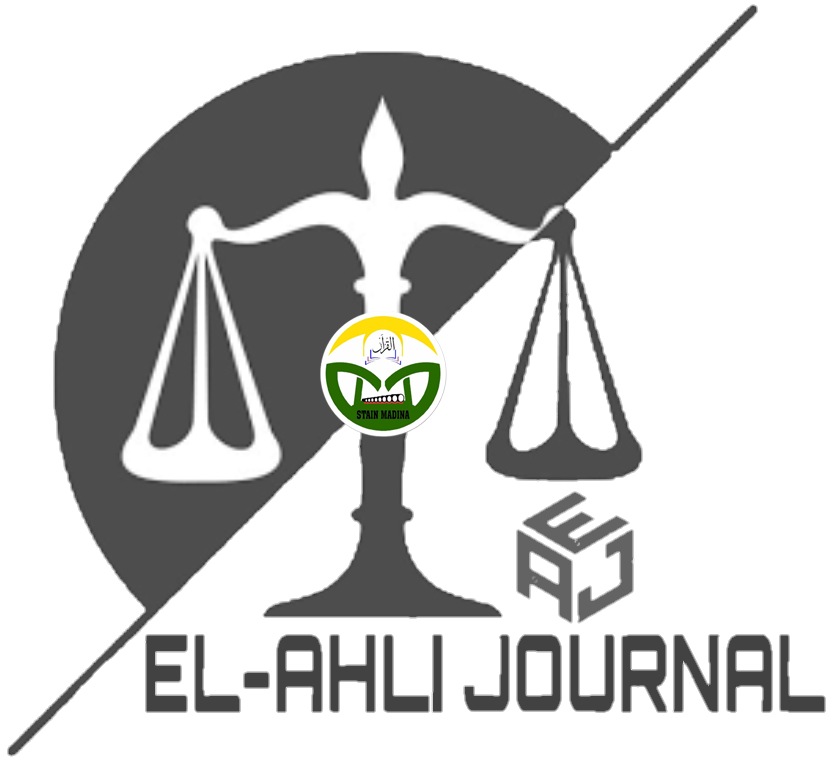AN ANALYSIS OF MUAMALAH LAW IN RUM TRADING IN KUALA SIMPANG: THE ROLE OF MUI FATWA AND JINAYAH QANUN
DOI:
https://doi.org/10.56874/el-ahli.v6i1.1996Keywords:
Buying And Selling, Rum, MUI Fatwa, QanunAbstract
This study examines the persistent practice of rum trading in Kuala Simpang, despite its prohibition under MUI Fatwa No. 4 of 2003 on halal standards and Qanun Aceh No. 6 of 2014 on Jinayah Law. Rum is commonly utilized in food and beverage preparation, imparting a sweet flavor with minimal alcoholic content. The research aims to analyze the prevailing rum trade practices and their implications in light of these religious and legal frameworks. Data were collected through interviews with rum sellers and consumers. Findings indicate that rum remains widely traded in Kuala Simpang, where it is frequently incorporated into cakes and beverages. According to MUI Fatwa No. 4 of 2003, such practices are deemed haram (forbidden), as even trace amounts of alcohol render consumption impermissible. Additionally, Aceh’s Qanun No. 6 of 2014 classifies rum as khamar (intoxicants), prohibiting its trade under Jinayah Law. Thus, the ongoing rum trade in Kuala Simpang violates both Islamic jurisprudence and regional legal statutes in Aceh
References
Abdul Manan, Hukum Ekonomi Syariah Dalam Perspektif Kewenangan Peradilan Agama, Ed. 1 (Rawamangun, Jakarta: Kencana, 2012), h. 26-29.
Ahmad bin Muhammad bin Hanbal bin Hilal bin Asad, Musnad Ahmad, diakses pada tanggal 12 Oktober 2020 melalui software Ensiklopedia Hadis 10 Imam Besar, Hadis No. 8337, diakses melalui situs http://maalhikmahkarangmojo.blogspot.com/
Ahmadi Miru, Sutarman Yodo, Hukum Perlindungan Konsumen (Jakarta: Raja Grafindo Persada, 2019), h. 4.
Al-Fauzan, Perbedaan antara jual beli dan riba (Salih Fauzan Solo: Attibian, 2002), h.55.
Burhan Bungin, Metodologi Penelitian Kualitatif Aktualisasi Metodologis Ke Arah Ragam Varian Kontemporer. (Jakarta:PT Raja Grafindo Persada, 2001),h 101-102.
Deddy Mulyana. Metodologi Penelitian Kualitatif: (Bandung : Remaja Roskadarya 2003) h.72.
Fatwa Dewan Syariah NasionalMajelis Ulama Indonesia No 4 Tahun 2003 tentang Standarisasi Fatwa Halal bagian keempat tentang masalah penggunaan nama dan bahan .
Huzaemah Tahido Yanggo, “Makanan Dan Minuman Dalam Perspektif Hukum Islam,” Jurnal Tahkim , Vol 2 No 1 (2013),h. 2.
Idri, Hadis Ekonomi Dalam Perspektif Hadis Nabi (Jakarta: Prenadamedia Group, 2015), h. 2.
M.Alimin, Etika dan Perlindungan Konsumen dalam Ekonomi Islam Fakultas Ekonomi UGM (Yogyakarta: Aswaja Presindo, 2014), h. 129.
Muchtar Ali,”Konsep Makanan HalaL Dalam Tinjauan Syariah Dan Tanggung jawab Produk Atas Produsen Industri Halal ”, Jurnal Ahkam, Vol 2 No 1(2016), h. 292.
Muhammad Bin Isa Bin Surah At-Tirmidzi, Sunan At-Tirmidzi, diakses pada tanggal 12 Oktober 2020 melalui software Ensiklopedia Hadis 10 Imam Besar, Hadis No. 1130, diakses melalui situs http://maalhikmahkarangmojo.blogspot.com/
Nasution, Konsumen dan Hukum, (Jakarta: Pustaka Sinar Harapan, 2015), h. 73.
Pasal 16 Qanun Aceh Nomor 6 Tahun 2014 Tentang Hukum Jinayat.
Ummu Kalsum, dkk, Hukum Penggunaan Destilasi Tetes Tebu (Rum) Sebagai Campuran Makanan Menurut Fikih Islam, Jurnal Bustanul Fuqaha, Vol.4, No.1m Tahun 2023, h.163
Wahbah Az-Zuhaili, Fiqh Islam Wa Adillatuhu 5, Terj. : Al-Kattani, (Jakarta : Gema Insani, 2011), h. 21.
Wizārah al-Awqāf wa al-Syu’ūn Al-Islamiyyah, “Al-Mausū`ah Al-Fiqhiyyah Al-Kuwaitiyah,” II (Riyadh: Dār al-Arqām, 1984), h. 95.
Yoyok Prasetyo, Ekonomi Islam (Bandung: Aria Mandiri Group, 2018), h. 3.
Downloads
Published
How to Cite
Issue
Section
License
All articles published in EL-AHLI: Jurnal Hukum Keluarga Islam are licensed under a Creative Commons Attribution-ShareAlike 4.0 International License (CC BY-SA 4.0).
Under this license, authors and readers are free to:
-
Share — copy and redistribute the material in any medium or format.
-
Adapt — remix, transform, and build upon the material for any purpose, even commercially.
Under the following terms:
-
Attribution — You must give appropriate credit, provide a link to the license, and indicate if changes were made. You may do so in any reasonable manner but not in any way that suggests the licensor endorses you or your use.
-
ShareAlike — If you remix, transform, or build upon the material, you must distribute your contributions under the same license as the original.
Copyright and Licensing Policy:
-
The author retains copyright and grants the journal the right of first publication with the work simultaneously licensed under the Creative Commons Attribution-ShareAlike 4.0 International License, which allows others to share the work with acknowledgment of the work’s authorship and initial publication in this journal.
-
Authors are allowed to enter into separate, additional contractual arrangements for the non-exclusive distribution of the journal's published version of the work (e.g., post it to an institutional repository or publish it in a book), with an acknowledgment of its initial publication in this journal.
Link to License:
https://creativecommons.org/licenses/by-sa/4.0/





